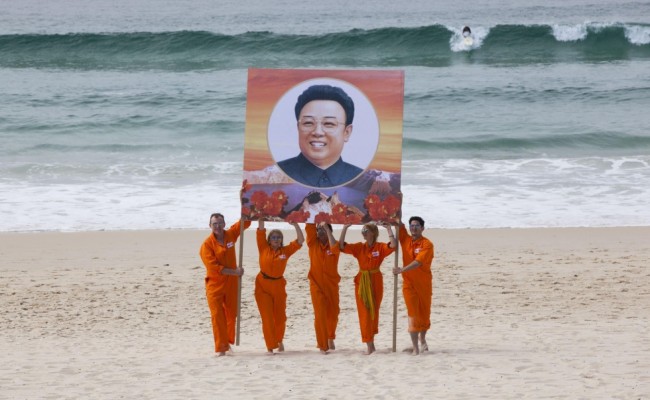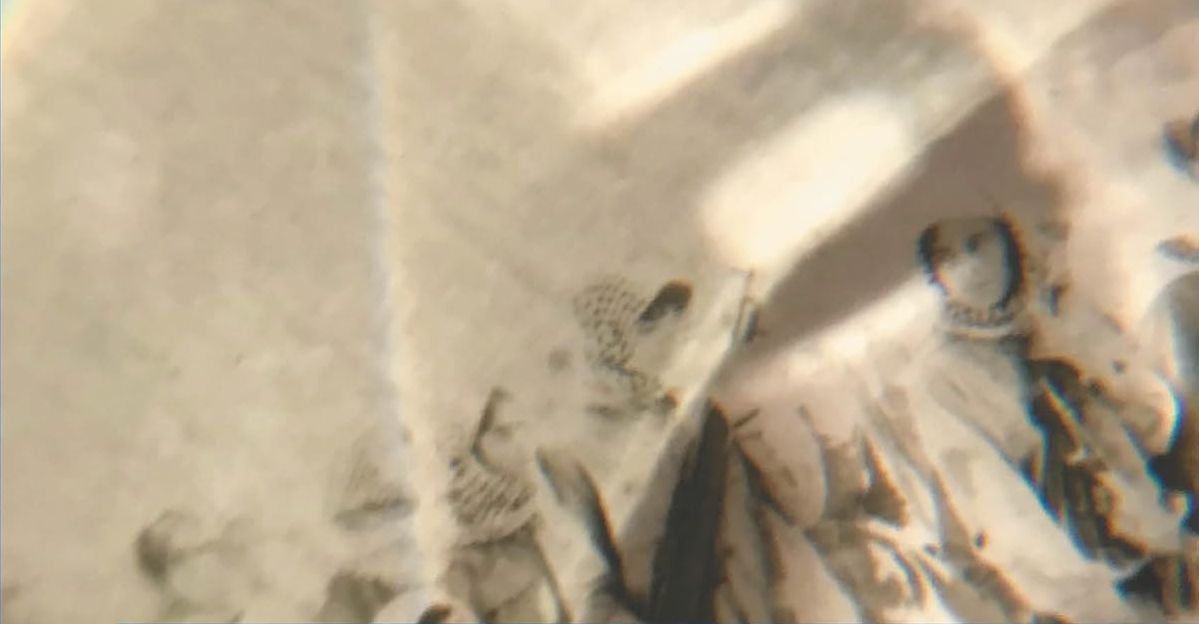All I want to do right now is watch North Korean propaganda films. This may sound odd given that Kim Jong-il wasn’t a particularly nice man but you’ve likely never seen films quite like these. These wholly unique, North Korean creations are worlds away from the artfully composed Nazi advertisements of Leni Riefenstahl’s Triumph of the Will (1935) and Olympia (1938), films that quickly came to define government-enforced propaganda films as exercises in large scale cinematic myth-spinning.
Using the twentieth century’s most broad-reaching artistic form, these films designed to indoctrinate the masses are easily dismissible to most folks. But as detailed in Anna Broinowski’s blisteringly funny documentary Aim High in Creation, North Korea’s propaganda industry is nevertheless full of high-kicking kung fu, magic, musical numbers, elaborate costumes and decadent production values. They are war movies brimming with action, romance, colour, and emotions as big as a Douglas Sirk melodrama that just happen to extol the evils of the west – predominantly Japan and the United States. They’re films in which characters shout dialogue like ‘Death to US imperialists!’ before blowing up what looks like a scale model of the naval boat from Cher’s ‘If I Could Turn Back Time’ video, sending it to the murky depths of the Korean Gulf.
It’s not an accident that these films seem as if they have a Hollywood sensibility to them. They’re just as rah-rah patriotic for the home team (to use Tony Abbott’s recent phrase) as Olympus Has Fallen (2013), except on the other side of the Pacific Ocean. Kim Jong-il, the late ‘Supreme Leader’ of North Korea, was in fact known to have prints of American films stashed away in locked vaults only to remake and refashion them into Pro-North Korea cinema. He is described in Aim High in Creation as the
nuclear bomb-loving, US war-machine-dissing, socialist dictator of North Korea. A propaganda mastermind so brilliant he even stage-managed his own funeral.
Aim High in Creation goes on to call Kim Jong-il a ‘cinematic genius’ for using his 1987 cinema manifesto to convince 24 million citizens that ‘he was a god and North Korea ruled the world.’ With inspiration like that, what could go wrong?
Broinowski is the director behind Forbidden Lie$, one of the most successful Australian documentaries of all time. With Aim High in Creation she is again dealing with the old expression that truth is stranger than fiction. Nominated for Best Direction of a Documentary at this past January’s AACTA Awards, the Sydney-based director became the first western filmmaker granted total access to this normally heavily-guarded country and its film industry. Labelling Kim’s manifesto as ‘cinematic kryptonite’, Broinowski enters North Korea with the intent on learning everything she can about the world’s most powerful propaganda factory in order to return home and fashion her own film as a means of stopping coal seam gas mining. ‘When you’re fighting a capitalist weapon on steroids,’ she notes, ‘get new weapons’, before a swirl of techno music engulfs the speakers and Kim’s omnipotent face emerges from Sydney Harbour. Yes, it’s that kind of movie.
As Broinowski gallivants around North Korea, touring filming locations, picnicking with filmmakers learning their methodology for empowering the people, and even filming a cameo in a movie, she has five actors back home studying and learning to act and work by the rules of North Korean cinema. What may sound convoluted is actually a keenly-observed piece of documentary filmmaking.
Fraught with deliciously hilarious absurdity as well as poignancy, it is four movies in one: a documentary about the North Korean film industry, a behind-the-scenes documentary about the production of an Australian film, a documentary about fracking, and then the short propaganda film itself that is the climax of the picture.
The first of these elements is by far the most interesting. The frank insight that Broinowski’s trip to North Korea gives to its previous unseen industry is funny, stunning, and is full of wonderful moments that paint a vivid picture of this tightly wound country. The security guard asking if he will get in trouble for answering questions, and two prominent North Korean directors debating whether Kim Jong-il would approve of the Australian’s intrusion are just two such examples. Likewise, when posing for a video to send to her Australian collaborators in Sydney, one of the North Korean filmmakers laughs and states, ‘Hey Australia, don’t come start a war again!’
It’s only slightly disconcerting, really.
If Broinowski wanted to paint a comparison between the two industries then she succeeded. It’s somehow embedded in our DNA to mock and criticise the Australian film industry. But while Red Dog (2011) at times felt like one big ad for the mining industry, by and large we are an industry that cultivates voices with things to say, whether it’s the asylum seeker satire (however grisly) of Wolf Creek 2 (2014) or the humdrum life of a domestic Goddess (2013). Be thankful we’re not being told what to make and say by our government. At least not yet.
Do the North Korean tactics work for Broinowski and her crew? That’s not necessarily clear. The coal seam gas initiative in Sydney Park that was the initial impetus for the documentary was ultimately cancelled, yet the industry chugs along both here and elsewhere. As for the participants, Peter O’Brien sulks through most of it, at odds with the methods extolled by the manifesto, but Susan Prior, Kathryn Beck, and Matt Zeremes, take to the material with the spirit of fun that was presumably intended.
The film’s most disappointing aspect is that the short film that Broinowski makes, the anti-coal seam gas propaganda that concludes the movie, isn’t very good. Lacking much of the grand 35mm glory of its North Korean counterparts, it lends the film a flat final note.
Thankfully the rest of the film is such a hoot that it doesn’t matter all that much. Aim High in Creation gave me a buzz that was similar to another chronicle of cinema history, Not Quite Hollywood (2007). Like that film, it made me want to seek out more of its subject than ever before, even in spite of the somewhat dubious quality of what’s presented. This is an entertaining and educational film, but most importantly it’s a fine example of what Australian filmmakers should always be proud to do: to inspire thinking, creativity, and discussion. Aim high, artists! Aim high for as long as you can!



